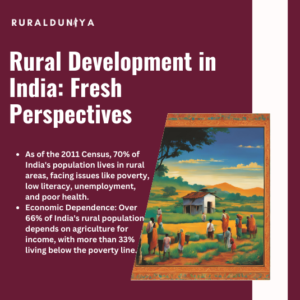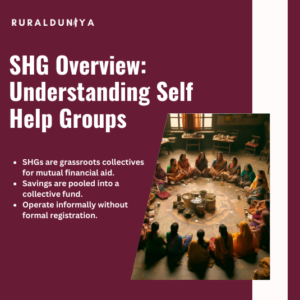When we talk about the India Pakistan conflict, most of us think of headlines, press conferences, or maybe even war movies. But for thousands of people living in India’s border villages, this conflict isn’t just news it’s their daily reality.
They live on the frontline, between peace and uncertainty. From bunkers built beneath kitchens to the distant hum of surveillance drones, this is their story. Let’s walk in their shoes for a moment. 🧭
India Pakistan Villages Beyond Border: Quick Flashback
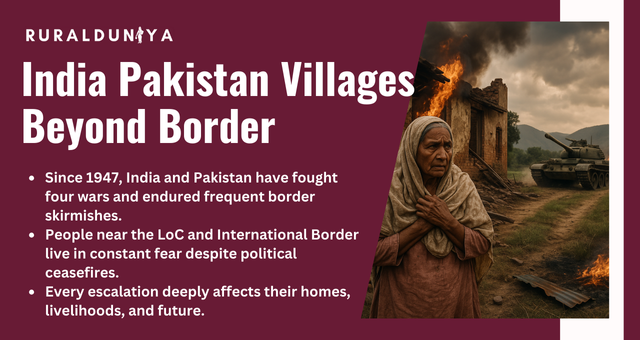
Since 1947, India Pakistan have fought four wars 1947, 1965, 1971, and 1999 (Kargil) and witnessed countless skirmishes. While political tensions come and go, for the people living near the Line of Control (LoC) and the International Border, fear is a part of everyday life. 🧨
In these border villages, every ceasefire feels like the calm before another storm. With each escalation, homes are damaged, fields are abandoned, and families are displaced.
Entire villages bear the emotional and economic scars of conflict—where rebuilding begins even before the smoke clears. 🔥
2025 Update: The Pahalgam Attack & Operation Sindoor
In April 2025, a deadly terrorist attack in Pahalgam, Kashmir took the lives of 26 innocent tourists. In response, India launched Operation Sindoor precision airstrikes aimed at suspected terror launch pads across the border. 🆕
This was followed by retaliatory strikes under Operation Bunyan al-Marsus, heightening tensions dramatically.
The impact? Civilians in border areas were forced into bunkers, roads were sealed off, and emergency kits were restocked.
Who Lives Here? The Reality of India’s Border Villages
Over 2,000 Indian villages are located within 10 kilometers of the Pakistan border. You’ll find them in: 🏘️
- Jammu & Kashmir (Poonch, Rajouri, Kupwara)
- Punjab (Fazilka, Gurdaspur, Pathankot)
- Rajasthan (Barmer, Jaisalmer, Sri Ganganagar)
- Gujarat (Kutch, Banaskantha)
In these villages, every child knows what a siren means. People live with half-packed bags, just in case. Many homes now have personal bunkers, and families sleep in shifts when tensions rise.
They’ve seen tanks pass, heard fighter jets overhead, and sheltered Indian soldiers during war.
How Indian Army Protects Its Skies and Villages
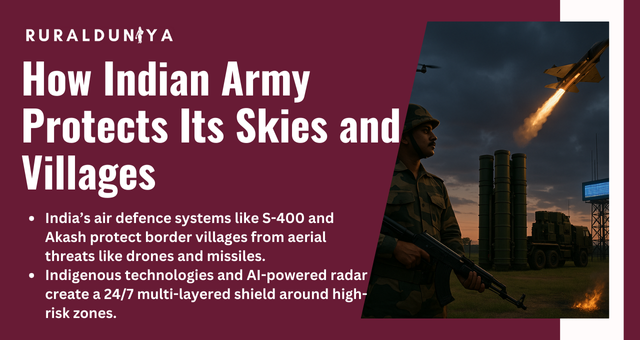
While our jawans stand tall at the India Pakistan border, India’s air defence system works silently but powerfully behind the scenes. Its mission? To protect border villages and cities from drone attacks, missiles, and fighter jets. 🚁💥
🇷🇺 S-400 Triumf
India’s most advanced air defense weapon, sourced from Russia, can detect and eliminate aerial threats from up to 400 km away. It has already been deployed in Punjab, Rajasthan, and Jammu & Kashmir key regions facing high-risk drone threats.
🇮🇳 Akash Missile System
A proudly indigenous defence solution, Akash is perfect for short- and medium-range threats. It’s been used to intercept drones and low-flying aircraft attempting to breach Indian airspace near the LoC.
🧠 AI & Radar Surveillance
With laser fencing, AI-powered radar stations, and thermal imaging, India has built a multi-layered shield that watches the skies 24/7. These systems have become critical in preventing missile attacks on villages and sensitive military zones.
These aren’t just defence systems—they are lifelines for border families. 🛡️
How Villagers Support the Army
In villages like Kupwara and Fazilka, families have generations of history with the Indian Army. Some served as porters during the Kargil War, while others today guide or support troops on patrol.
During the 2025 escalation, it was villagers who helped shift the injured, provided shelter to jawans, and relayed ground information.
For them, Jai Hind is more than a slogan. It’s their life story. 🇮🇳
Why Border Villages Are Often Targeted
Sadly, targeting villages has a grim purpose:
- It causes panic and displacement
- It stretches India’s relief and response system
- It interrupts civilian morale
- It pressures authorities politically and socially
Areas like Hiranagar, Barmer, and Poonch have repeatedly seen shelling—not randomly, but with chilling precision. 🎯
War Isn’t Just Bullets—It’s Lost Livelihoods
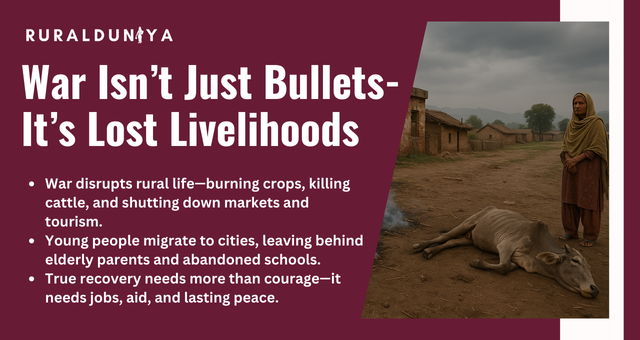
War leaves more than physical scars. In these areas:
- Crops are burnt or abandoned
- Cattle are lost or killed
- Markets shut down, and trade stops
- Tourism, a lifeline in regions like Kashmir, vanishes overnight
Many young people migrate to cities in search of safety and jobs, leaving behind aging parents and empty schools. Entire economies shrink. 💸
Survival here doesn’t just depend on bravery it depends on aid, jobs, and peace. 🌾
Government Relief & Army Action
To help, the government has launched several initiatives: 🛠️
- Bunkers for individual homes
- Compensation for crop, livestock, and home loss
- Mobile health clinics run by Army doctors
- Installation of emergency sirens and community shelters
Programs like the Border Area Development Programme (BADP) aim to build roads, schools, and clinics but implementation remains slow.
For villagers, it’s not about headlines. It’s about whether relief reaches before the next round of shelling. ⛑️
Tech on the Border: Smarter & Safer
India has invested in: 📱
- AI-powered cameras
- Thermal sensors
- Smart fencing and drone jammers
This new tech is a game changer helping both security forces and civilians sleep better at night. The focus now is early warning, rapid response, and resilient recovery. 🔭
Real Stories from the Border
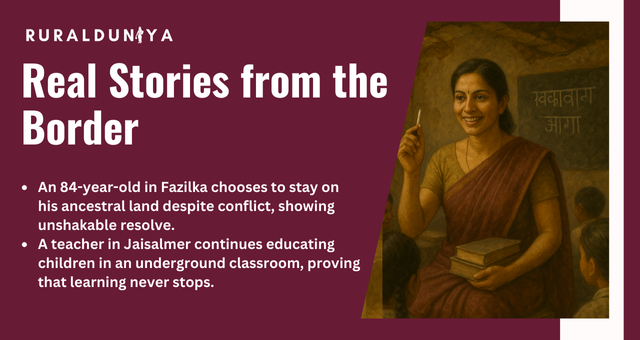
🧓 In Fazilka, an 84-year-old refuses to leave. “This land raised me. I won’t run,” he says.
👩🏫 In Jaisalmer, a teacher holds classes underground in a damaged school. “Education must go on,” she smiles.
These aren’t characters—they’re everyday heroes of rural India. 🎬
It’s Time We Talk About This More
Border life isn’t just about patriotism—it’s about pain, sacrifice, and resilience. It’s also about the right to peace. 🛑
Every child deserves safety. Every mother deserves sleep. Every farmer deserves rain—not rockets.
And peace between India and Pakistan shouldn’t be seasonal. It should be permanent. ❤️
Saluting the Spirit of Border India
When we talk about India Pakistan tensions, we often focus on diplomacy or defence but it’s the people in the border villages who live that reality every day.
When we cheer for the flag, let’s remember those who live beside it—who fight battles both seen and unseen. They are the heartbeat of the nation, holding the line with strength, pride, and silent courage.
Here’s to making sure their voices aren’t just heard during war but supported during peace. 🕊️🇮🇳
FAQs
What are India’s key air defence systems used along the Pakistan border?
India uses the S-400 Triumf, Akash missile system, and radar-based AI surveillance to detect and stop drones, missiles, and aircraft near the India Pakistan border.
How many Indian villages are near the Pakistan border?
Over 2,000 villages in India lie within 10 km of the border, mainly in Jammu & Kashmir, Punjab, Rajasthan, and Gujarat.
What happens to people in border villages during attacks?
Villagers move to bunkers or shelters, schools are shut, and farming stops. Many stock up on essentials and stay alert for sirens and government warnings.
How does the Indian Army help people in border villages?
The Army provides medical aid, builds bunkers, runs rescue and relief operations, and often helps restore life after cross-border incidents.

Nishank is a social impact enthusiast with a solid foundation in public policy, micro-enterprise, and agribusiness. Growing up in a farmer’s family has given him a profound connection to rural communities, fueling his passion to empower people towards self-reliance. He completed his undergraduate studies at the Delhi University and earned a master’s degree in Rural Management from National Institute of Rural Development & Panchayati Raj in Hyderabad.


